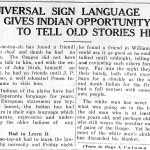May 6, 1928
The Daily Journal Capital
Microfilm Roll: MN00276
On this day in Osage country, The Daily Journal-Capital published an article telling the story of how a deaf and mute Osage tribal member was able break the language barrier, or lack thereof, and once again communicate with his people.
Pah-se-to-pah, one of the most colorful members of the Osage tribe, was both deaf and mute. He is described as an Indian man, in his late fifties, who took on the fashion of the white man, yet who continued to paint his face as the Osage once did.
The article states that it was not until he met J.P. Williams that Pah-se-to-pah was able to find a way to communicate. Williams, “a well-educated Ponca Indian,” taught an old sign language to Pah-se-to-pah. The “Esperanto” language, as referred to in the article, is an old language “which is accurate, expressive, and understood by the older Indians of any tribe.” This language is most likely what Jeffrey Davis refers to as the Plains Indian Sign Language, a language still used today by American Indians. Pah-se-to-pah seems to have had no trouble in learning his new language. He and Williams carried on conversations for nearly all night long, “wav[ing] their hands, both silent except perhaps for a chuckle.” The sign language opened many doors for Pah-se-to-pah, allowing him to communicate with people for the first time since losing his hearing.
To conclude, there are a couple of discrepancies found in the article that should be disproved. Primarily, the article claims that Pah-se-to-pah was born both deaf and mute, however, other evidence notes that his disabilities were caused by a horse racing accident that occurred when Pah-se-to-pah was a young boy. The article then goes on to insinuate that he was not accepted by his own tribe, yet Pah-se-to-pah was a cherished member of the Osage tribe. As an adult, the Osages included him in the majority of their celebrations. For instance, Pah-se-to-pah lead nearly all of the Osages’ parades, his most cherished artifacts were included in the opening exhibits of the Osage Tribal Museum, and Pah-se-to-pah even served as an escort for First Lady Eleanor Roosevelt on her first visit to the Osage Nation.
Morgan M. Guzman
“Universal Sign Language gives Indian Opportunity to Tell Old Stories Here” The Daily Journal-Capital. May 6, 1928, p. 1 & 4. Microfilm roll number MN00276. Sequoyah National Research Center, Little Rock, Arkansas.
Further Reading
Davis, Jeffrey. “Native American Signed Languages.” Oxford Handbooks. http://www.oxfordhandbooks.com/view/10.1093/oxfordhb/9780199935345.001.0001/oxfordhb-9780199935345-e-42 Date accessed April 6, 2018.

